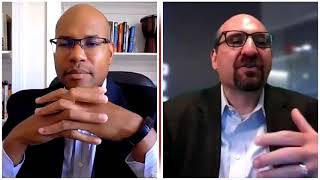Hubbard Radio Washington DC, LLC. All rights reserved. This website is not intended for users located within the European Economic Area.
On Air: Federal News Network
Trending:
A long-serving career executive has kept the proverbial trains running
You might not know him by name, but Federal Drive host Tom Temin's guest oversees an operation that touches thousands of federal employees. He has also worked...
You might not know him by name, but the Federal Drive with Tom Temin‘s guest oversees an operation that touches thousands of federal employees. He has also worked facilities, operations and budget analysis across the government. Now he’s among the new members of the National Academy of Public Administration: Byron Adkins.
Interview Transcript:
Tom Temin And so to dispel the mystery right away, you are the director of the Interior Business Center, and that is kind of the king of operations type of agencies with shared services across the government. Tell us what that’s all about. Exactly.
Byron Adkins Absolutely. So we are a federal share service provider recognized by OMB and OPM. First of all, we are a payroll provider similar to the National Finance Center, and we pay about almost 300,000 employees across the federal government. That’s the largest service that we provide. But we also provide back office H.R. Financial Management, General Ledger accounting. And we do acquisitions cradle to grave, as well as financial assistance. And then we also have moved into innovative with robotics process automation and in turn to AI as well if you can believe that as well. So we’ve been expanding some of our service offerings, but we provide anything that would be mission enabling functions for most agencies.
Tom Temin Now agencies are always saying IT is an enabler of their mission, but in many ways your mission is IT. And so I guess I should ask the magic question How’s your infrastructure these days?
Byron Adkins Infrastructure could use a little work. It’s an aging infrastructure, and there’s a lot of opportunity for us to improve that and upgrade that, particularly from a user experience perspective. And so we are in a position where that could vastly improve and probably could use some significant investment. But we’re working actively to improve that and to better our systems for our users.
Tom Temin And how did you get to Interior Business Center from the earlier part of your career?
Byron Adkins I’ve been very fortunate. I actually was first introduced to the Interior Business Center when I was on a senior executive candidate development program, and I did a long term detail there back in 2012. And so that’s where I got bit by the shared Services bug. And I was there almost a year, got to meet with some very interesting people. Some of the folks that were working there are still actually there and I really enjoyed it was so entrepreneurial. It was fee for service. You kind of eat what you catch. I mean, I got bit by the bug and so I took a couple of opportunities. I’m working in facilities and construction for the Department of Commerce, and three years ago I boomerang back and was fortunate enough to land a director position.
Tom Temin Right. So the same code is running that you saw, you know, a dozen years ago when you were there the first time.
Byron Adkins Unfortunately, you know, they say when your infrastructure is older than your youngest employee, you need to replace it. And so we have that in some instances.
Tom Temin All right. But this is kind of a theme of your background is operations analysis, trying to make things operate properly. Tell us more about what you’ve done in the past. I know you served a stint at the Army Corps of Engineers also.
Byron Adkins So I was a ROTC student years ago back at North Carolina A&T. So I actually commissioned into the Army Corps of Engineers, and they gave you this opportunity to select your branch. And I said, “Well, I’m an engineer by trade” because I’m an electrical engineer. I should try the Corps of Engineers. And I was thinking I was going to be doing some really sexy hydropower and dam safety or engineering construction. And unfortunately, all army engineers start off as combat engineers. We call that infantry with a shovel. And so you if you think about it, anytime you occupy a location, it doesn’t necessarily have the necessary infrastructure. So roads and bridges and so forth, demolition, that’s the type of work I was doing for the five years I was with the Corps of Engineers. After I transitioned from there, I had the opportunity to work for the Research Development Command for the Army, now called the Army Future Command, working on counter-ID programs, did that for about three years, and then I transitioned to the federal government working in budget and finance.
Tom Temin And you were also at agriculture in the Office of Operations. Did you happen to touch their business center, which I guess is complementary to the Interior Business Center?
Byron Adkins I did not. Besides them paying me every two weeks, I did not have an opportunity to work within their business center, but I did keep the lights on for them.
Tom Temin All right. We’re speaking with Byron Adkins. He is the director of the Interior Department’s Interior Business Center. He’s also a new inductee to the National Academy of Public Administration. Tell us about the rise to senior executive service. I mean, those that enter the government, Young may have that aspiration. What does it take, do you think, in the long term? How do you build a career such as yours?
Byron Adkins You know, I’ve been extremely fortunate and it may look like my career has been linear, but it’s really been taking advantage of opportunities that have come before me. I mentioned the Senior Executive Candidate Development Program that really accelerated my career and provided some opportunities. And about ten years ago was when I first entered into the senior executive ranks. And so really a lot of mentorship, a lot of personal development and growth and being at the right place at the right time. I won’t say I’m so smart that I got here on my own, but opportunities presented themselves and I was able to kind of rise to the top there. And I’ve been very fortunate to be here.
Tom Temin And as you mentioned, you are an electrical engineer by education. So many people go to school with public administration degrees or whatever soft types of degrees. You got to senior executive ranks and you oversee, you know, a couple of thousand people that operate that center. And from an engineering standpoint, so what’s the better way? Engineering and then learn public administration or come in with public administration and then learn what you need to do about engineering?
Byron Adkins Well, I’m a bit biased. I think I always say engineering provides a great foundation for any career, a public administrator and be an engineer. But an engineer can be a public administrator. So I would say it provided a great foundation to work with teams doing problem solving, which can be applied to a number of careers. And so I definitely can say that I benefited from that. I do have a MPA and an MBA as well, but it was a good foundation for me.
Tom Temin All right. So you’re not that old yet, actually. So what do you hope to do long term here?
Byron Adkins You know, before I was called a lead, I was called to serve. And so I’m really looking for the opportunity to continue to serve and provide the government. This is why I love the Interior Business Center and the opportunity to not just serve the Department of Interior, but over 150 different agencies for mission enabling functions. Also this opportunity with NAPA, it’s a service organization. It adds extra amount of value to the government and looking to really participate in some studies and better our government. And so that’s what I’d like to do in the near future. I’m not going anywhere anytime soon.
Tom Temin And you mentioned there is probably some infrastructure updating that the Interior Business Center needs. There was recently a NAPA report that was pretty dire about the Agriculture Business Center and sometimes it seems manifest to the people there, Gosh, we need this money to do this. But manifest doesn’t mean Congress says, yeah, you’re right, Here you go. You have some budget analytics background. You do have that engineering background. How can you bring that together to make a good business case for the dollars that instinctively, you know, are needed for these types of modernizing as well?
Byron Adkins That’s a great question Tom, and we’re actively pursuing that. A big piece of that is showing the data, showing the infrastructure that we have and what can happen if we don’t invest in this type of infrastructure. The other thing is that we’re not going at this alone. We have partnered with the National Finance Center as well to figure out how can we help each other, how can we partner towards a solution, recognizing that there’s a finite amount of resources to make these large capital investments to replace the infrastructure? When I talk about primarily, I’m talking about our payroll and personnel system, which is rather old and antiquated, but it works and is secure. And so a big piece of that is just getting a coalition of the willing and folks that can clearly see how you do not want to have a situation where we cannot pay half of the federal government. How can we go about this as a period of funding in the capital investment necessary to make sure we can sustain operations? And so we’re going about that in a number of different ways, particularly with the Shared Services Leadership Coalition supporting us and getting in the right rooms and spaces to request that type of funding.
Tom Temin And not to put you on the spot. But should the government have two matching business centers, maybe one really super duper modern one could do the job that the two are doing now?
Byron Adkins You know, everything’s on the table, Tom. You know if someone’s willing to support it and fund it? We’re still in a better place than we are now. That is something that we floated around and a consideration to figure out, and that’s part of the partnership. You know, we also are in the process and have requested technology modernization funds and some of some of the feedback that they gave as well say, hey, both you guys have requested funding. Perhaps we should look at this together and perhaps there’s a single source to provide payroll. So we’re looking at all options here, whoever’s going to provide some funding and we’ll consider it.
Copyright © 2024 Federal News Network. All rights reserved. This website is not intended for users located within the European Economic Area.
Tom Temin
Tom Temin is host of the Federal Drive and has been providing insight on federal technology and management issues for more than 30 years.
Follow @tteminWFED





